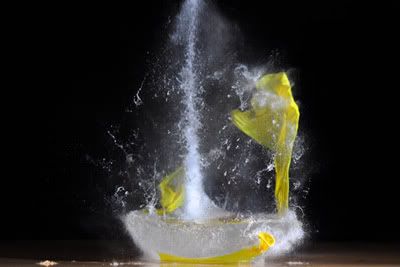After a discussion on settings to use for a dance shoot I decided to put my theory to test - when things are moving quickly I like to use matrix metering dialed in at -2 [ for the black background ] . I set up ''Stinky'' with a black background and a 'spotlight' shining on him from the top/front .
I started off with spot metering in the centre of his face . Many people use spot metering in situations like this with good results . However the type of dances I've been photographing have been fast moving at times with rapidly changing light along with the fact that I often shoot wide shots as well which can make spot metering difficult under these conditions .
I'm not telling anyone what type of metering they should use , just showing my tests and recording my observations on the subject - draw your own conclusions . Remember these are all taken with the D40 so spot and centre weighted should be the same as any other camera while matrix might be a slightly different 'program' to other models .
First the spot metering centre focus point on his nose [ keep in mind that often people who spot meter off human skin add 0.7 stops of exposure since human skin is seldom 18% gray ]
 It maintains an accurate reading as I move back which would make it a good choice for subjects that aren't leaping around like crazy with lights going bright and dim the whole time ....
It maintains an accurate reading as I move back which would make it a good choice for subjects that aren't leaping around like crazy with lights going bright and dim the whole time ....
But it just starts to 'lose it' when we go wide .

Now the centre weighted metering shots . centre weighted metering is more like a calculator than a computer program . You can work out mathematically what it is going to do with a set amount of light at a certain subject size - no surprises like with matrix metering !

If the subject fills a large percentage of the centre of the frame the metering will do a good job .
As you zoom/move back though , and more darkness around the subject fills the frame the metering thinks the lighting has got dimmer and adds exposure ...

and adds more as you go further back ....

and even more as the subject gets very small in the frame ....

very predictable and ''reliably so'' if you are going to use a long lens with the frame filled with the subject most of the time .
Now we get to matrix metering

There's good news and bad news . The bad news is that it is very negative , it doesn't 'see the light' , rather it 'sees the darkness ' and tries to brighten it . The good news is that it is rather consistent with its negativity which just means making one compensation adjustment .




All I can say is that "yikes!" it has blown the highlights but with a total of only 1 stop of difference between a large subject and a small subject against a dark background
 .
.So I dialed in -2 in matrix metering and came up with these results .....




Notice that the results aren't exactly two stops less in each situation [ compared to the original results ] but take into account slight movement and the fact that there will be a lot of that on a dance stage and in my opinion I would say that it is a pretty reliable way of metering when things are moving quickly .
It almost seems like the solution to lots of different coloured objects running around against a dark background is ''meter for the black background at -2" and ignore the subjects . Ok this isn't exactly how matrix metering works but it's an easy way for me to remember it .
So there we have the results , no seriously blown highlights and a quick levels bump and we're away .
With the last dance I shot I only had to move the left [black] slider because the background was still one segment to the right since there was still a fair amount of light on it . The highlights were all ok and the interesting thing is that when I did that levels adjustment most of the noise went away and in the awful red lighting a lot of the red died down as well .




No comments:
Post a Comment